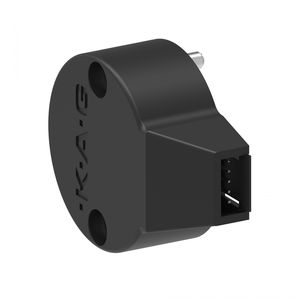
- Detection - Measurement
- Position, Speed and Acceleration Measurements
- Incremental rotary encoder
- Kählig Antriebstechnik GmbH
- Company
- Products
- Catalogs
- News & Trends
- Exhibitions
Incremental rotary encoder IGM x/y LDmagneticnon-contactanalog

Add to favorites
Compare this product
Characteristics
- Type
- incremental
- Technology
- magnetic
- Construction
- non-contact
- Output signal
- analog, RS-422
- Supply voltage
- 24 Vdc, 5 VDC, 12 Vdc
- Material
- plastic
- Protection level
- wear-resistant
- Applications
- for motors
- Incremental encoder résolution (pulses per revolution
Min.: 8 unit
Max.: 1,024 unit
- Process temperature
Min.: -20 °C
(-4 °F)Max.: 85 °C
(185 °F)
Description
Next to the optical encoders or incremental encoders are the magnetic encoders. Here, magnetic field sensors are used to determine the angular position. The magnetic field generated by a permanent magnet is measured by the sensor. These encoders are preferred for applications where a robust design is required.
Characteristics of a magnetic encoder
The magnetic encoders are characterised by a contactless and wear-free magnetic incremental encoder. This is equipped with Hall sensors and a permanent magnet pole wheel with alternating polarities. There is a 1-channel and a 2-channel version, each with a 90° phase offset. The output level depends on the supply voltage (5V-24V). The output of the encoder is available either with pull-up resistor or optionally with open collector. In addition, extended protection circuits or an integrated design are possible.
• Contactless and wear-free working magnetic incremental encoder
• Amplitude depending on the operating voltage
• Open collector output
• Integrated pull-up resistors
• Operating voltage = 4.5V – 24V
• Integrated version (IGMi) possible LineDriver function possible (LD)
• For further information, please refer to the respective data sheet
Catalogs
No catalogs are available for this product.
See all of Kählig Antriebstechnik GmbH‘s catalogsRelated Searches
- KAG rotary encoder
- KAG incremental encoder
- KAG incremental rotary encoder
- Optical rotary encoder
- Magnetic rotary encoder
- KAG DC rotary encoder
- KAG analog rotary encoder
- KAG 5 VDC rotary encoder
- Digital output rotary encoder
- 24 Vdc rotary encoder
- 12 Vdc rotary encoder
- KAG non-contact rotary encoder
- KAG motor rotary encoder
- RS-422 rotary encoder
- KAG plastic rotary encoder
- 2-channel rotary encoder
- KAG wear-resistant rotary encoder
*Prices are pre-tax. They exclude delivery charges and customs duties and do not include additional charges for installation or activation options. Prices are indicative only and may vary by country, with changes to the cost of raw materials and exchange rates.







